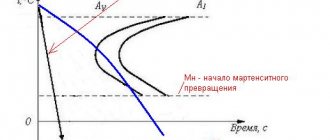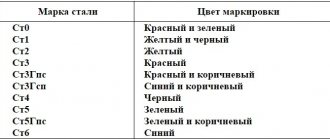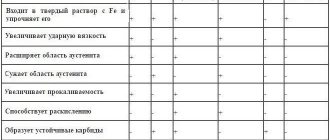Hardenability of steel
Hardenability is the ability of steel to acquire a martensitic or triple-martensitic structure to a certain depth during quenching. The hardenability of steel depends on the critical cooling rate, which depends on the chemical composition of the steel. So, for example, if the actual cooling rate in the core of a part during hardening is higher than the critical rate for this grade of steel, then the part will have through-hardenability. In this case, the depth of the hardened zone is taken to be the distance from the metal surface to the semi-martensitic structure. Semi-martensitic is a structure that consists of 50% martensite and 50% troostite. The width to the semi-martensitic zone in a cylindrical specimen is called the critical diameter or through-heating section size.
The higher the hardenability of steel, the lower the critical quenching rate, i.e., the higher the stability of supercooled austenite.
The hardenability of steel is determined according to GOST 5657-69 “Steel. Test methods for hardenability.” (the document will open in a new window) GOST describes the so-called end hardening method. The experimental results are expressed graphically in “hardness-distance” coordinates. Those. The graph shows the change in hardness along the cross section after hardening. The hardenability of steel, even within the same grade, can vary significantly. This is due to the fact that hardenability depends on the steel composition, grain size, product geometry, etc. In this regard, the hardenability of steel is characterized not by a curve, but by a hardenability band. It must be taken into account that even rated hardenability strips will not always correspond to the actual hardenability of the product.
Cooling methods during hardening
When steel products are rapidly cooled during hardening, there is a risk of large internal stresses occurring, which leads to warping of the material and sometimes cracks. To avoid this, where possible, it is better to cool steel parts in oil. Carbon steel, for which such cooling is not possible, is better cooled in water.
In addition to the cooling environment, the internal stress of steel products is affected by how they are immersed in the cooling environment. Namely:
- products with a thick and thin part in the quenching liquid with the bulky part first;
- If the product has an elongated shape (drills, taps), it must be immersed strictly vertically, otherwise they may warp.
Sometimes it is not necessary to harden the entire part, but only part of it. Then local hardening is applied. The product is not completely heated, but the entire part is immersed in the quenching liquid.
Hardenability of steel
Hardenability - the ability of steel to increase hardness as a result of hardening. This characteristic depends to a greater extent on the carbon content in martensite and to a lesser extent on the content of alloying elements. [quote from the book “Materials Science”, M.Yu. Lakhtin, 1990]
There is also an alternative option for determining the hardenability of steel. Hardenability - the ability of steel to accept hardening, i.e. form a martensitic structure. This interpretation of hardenability is based on determining the hardening of steel and determining the critical cooling rate: hardening - heating steel to a temperature above the critical temperature or the temperature of dissolution of excess phases, holding and cooling at a rate above the critical. The critical cooling rate is the minimum cooling rate of austenite in the region of its minimum stability, at which the decomposition of austenite into a ferrite-cementite mixture is suppressed and at which the martensite structure is ensured.
Types of steel hardening
There are many ways to harden metal. Their choice is determined by the composition of the steel, the nature of the product, the required hardness and cooling conditions. Stepwise, isothermal and light hardening are often used.
Hardening in one environment
Referring to the graph of cooling curves for various hardening methods, you can see that hardening in one environment corresponds to curve 1. It is easy to perform such hardening. However, it is not suitable for every steel part. Due to the rapid decrease in temperature in steel of variable cross-section, temperature unevenness and high internal stress occur in the temperature range. This can cause the steel part to warp and crack.
Figure No. 2. Cooling curves .
A high carbon content in steel parts can cause volumetric changes in structural stresses, and this, in turn, threatens the appearance of cracks.
Hypereutectoid steels, which have a simple shape, are best quenched in one environment. To harden more complex shapes, hardening in two environments or step hardening is used.
Hardening in two environments (in Figure No. 2 this is curve 2) is used for tools made of high-carbon steel. The method itself consists in the fact that the steel is first cooled in water to 300-400 degrees , after which it is transferred to an oil environment, where it remains until it has completely cooled.
Step hardening
During stepwise hardening (curve 3), the steel part is first placed in a salt bath. The temperature of the bath itself must be higher than the temperature at which the martensitic transformation occurs (240–250 degrees) . After the salt bath, the steel is mixed into oil or air. Using step hardening, you don’t have to worry about the part warping or cracks forming in it.
The disadvantage of this hardening is that it can only be used for carbon steel workpieces with a small cross-section (8–10 mm). Step hardening can be used for parts made of alloy steel with a large cross-section (up to 30 mm).
Isothermal hardening
Isothermal hardening on the graph corresponds to curve 4. Hardening is carried out similarly to step hardening. However, steel is aged longer in a hot bath. This is done in such a way as to cause complete disintegration of the austenite . In the diagram, the shutter speed is shown on the S-shaped line by points a and b. Steel that has undergone isothermal hardening can be cooled at any speed. The cooling medium can be molten salts.
Advantages of isothermal hardening:
- steel is almost impossible to warp;
- no cracks appear;
- viscosity.
Light hardening
To carry out such hardening, a specially equipped furnace equipped with a protective environment is required. In production, to obtain a clean and bright surface of hardened steel, step hardening should be used. After this, the alloy is cooled in molten caustic alkali. Before the hardening process, the steel part is heated in a salt bath of sodium chloride at a temperature 30–50 degrees above point Ac1 (see “Critical point diagram”). The part is cooled in a bath at 180–200 degrees. The cooling medium is a mixture consisting of 75% potassium hydroxide, 25% sodium hydroxide, to which 6–8% water (based on the weight of salt) is added.
Hardening with self-tempering
Used in the production of tool steel. The main idea of hardening is to remove the steel part from the cooling medium until it is completely cooled. The withdrawal occurs at a certain point. A certain amount of heat is retained in the core of the steel part. Subsequent vacations are made at his expense .
After the steel product reaches the required temperature for tempering due to internal heat, the steel is placed in a quenching liquid for final cooling. Figure No. 3—Table of tarnish .
Tempering is controlled by the colors of tarnish (see Figure No. 3), which is formed on a smooth metal surface at 220–330 degrees.
Using self-tempering hardening, sledgehammers, chisels, plumbing hammers and other tools are made, which require high surface hardness while maintaining internal viscosity.
Steel hardenability bands
Supplier of chemical products - https://www.dcpt.ru
Defects during hardening of steel
- Insufficient hardness . Occurs if there was a low heating temperature, short holding time at operating temperature, or insufficient cooling rate. The fix is to apply a more energetic environment; anneal and then harden.
- Overheating . Occurs if a steel part is heated to a temperature exceeding the permissible one. When overheated, a coarse-grained structure is formed, which leads to brittleness of the part. Can be corrected: by annealing and hardening at the right temperature.
- Burnout . When a steel part is heated to a high temperature close to the melting point (1200–1300 degrees) in an oxidizing atmosphere. Oxygen penetrates into steel products and oxides form along the grain boundaries. This kind of steel cannot be repaired.
- Oxidation and decarbonization . In this case, scale (oxides) form on the surface of steel parts, and carbon burns out in the surface layers of the steel. This marriage cannot be fixed. To prevent defects, ovens with a protective atmosphere should be used.
- Warping and cracks . They arise due to internal stress. Cracks are an irreparable defect. Warping can be removed by straightening or straightening.









